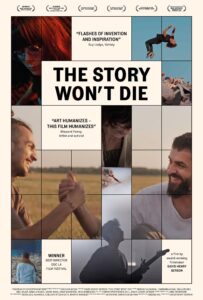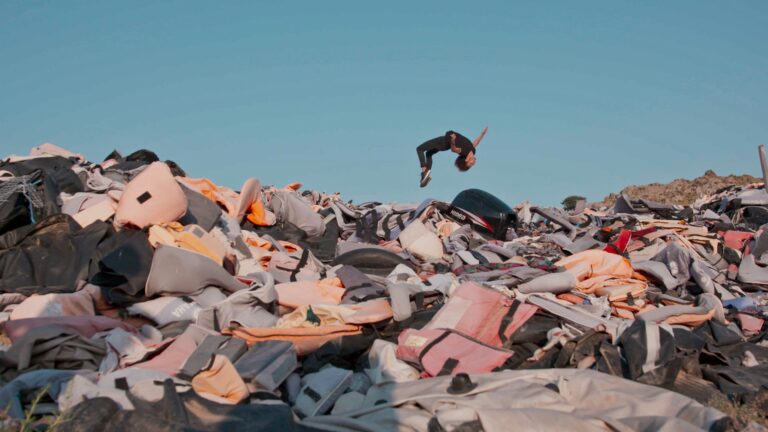Today, June 21, is World Refugee Day. It’s no coincidence then that it’s the day chosen for The Story Won’t Die to be released worldwide on major streaming platforms. It’s the new documentary by award-winning filmmaker, David Henry Gerson— an inspiring, timely look at a creative young generation of Syrian artists using their work to protest and process the aftermath of the largest and longest displacement of people in this recent part of history.
“I’ll tell you the whole story/ since the ocean took me/ and got me through the checkpoint/ then I’d swallowed the first shiver/ and thought that I’m all done and ready.” These are the first verses sung by the Berlin-based Syrian singer-songwriter Anas Maghrebi. His song narrates the impressions of a refugee, one representing so many, and serves as a preamble to reveal the rest of the featuring talents: rapper Abu Hajar, female rockers Bahila Hijazi and Lynn Mayya, breakdancer Bboy Shadow, choreographer Medhat Aldaabal, and visual artists Tammam Azzam, Omar Imam and Diala Brisly.
The Story Won’t Die details from the outset the basic situation: “Since 2011, over half a million people have been killed in Syria. Half of Syria’s population, 13 million people, have become refugees. This is the largest displacement of people since World War II.” Then the film begins to unfold. We’ll listen to music, from the surprising flow of rap in Arabic to the heartfelt melodies of a female rock band. We’ll admire dance moves. We’ll enjoy different works of art. The daily portrait of a legion of exiled talents “who fled to free their voices.”
David Henry Gerson broke out as a filmmaker with All These Voices, a film about artists at the end of World War II, which earned him a Student Academy Award in 2016. “That same year there was a short film about the crisis in Lesvos, called 4.1 Miles, by Daphne Matziaraki, and it opened my eyes to the fact that the Syrian Civil War has been the largest and longest ongoing displacement of people since WWII,” David says, as he begins to unravel the path that led him to make The Story Won’t Die: “My grandparents were survivors of WWII, my father was born in a refugee camp after that war, and in many ways, I was searching in this film for my own roots and for questions that always haunted me. How do we process war? Survive survival? How does the artist go about making work of their own immediate traumatic experiences? This interest, coupled with my DNA urging me to get curious about the Syrian Civil War, led me to begin this search…”
“We set out with a structure in mind, and with certain artists we knew we wanted to get to know. But one person led to the next, and we started meeting more and more incredibly talented musicians, dancers and artists who were doing the nearly impossible work of actively looking into the darkness they have run from,” explains David when asked about his preconceived idea of what he wanted to document. “That sort of resilience was continually inspiring to me and kept us going to just be curious about where the story would unfold.”
“We set out with a structure in mind and with certain artists we knew we wanted to get to know. But one person led to the next and we started meeting more and more incredibly talented musicians, dancers and artists who were doing the nearly impossible work of actively looking into the darkness they have run from,” explains David when asked about his preconceived idea of what he wanted to document. “That sort of resilience was continually inspiring to me, and kept us going to just be curious about where the story would unfold.”
From his interest in the war process in Syria, Gerson realized how art was also actively used to protest. “We brought on co-producer, Abdalaziz Alhamza, and he introduced us to rapper Abu Hajar and visual artist Diala Brisly, who were more proactively making protest art as a means of bringing awareness to what was beginning to happen in their homeland.”
“I think learning about a conflict is in many ways like getting to know a person. You see facts and data from afar, newspaper articles and videos. You get an overall concept that there is a war. Then you see posts, social media, and eventually artwork. You get a more rounded-out view. But sitting down with people who have experienced war zones, hanging out together, looking them in the eye and hearing their stories, learning how Syria has stayed with them even after leaving, and how the war informs their music and art, really brings everything to a new level of understanding,” tells David.
To conclude, Gerson emphasizes the transcendence of art: “Over the course of making the film, I learned an incredible amount about Syria – and there’s still an immense amount that I’m learning of that conflict. But it’s the soulful songs, flashes of wry images interpreting those horrors, movement, lyrics and paintings that sit now in my bones. I fear that as time goes on, we tend to forget conflicts. But it’s my belief that artworks live on, and the cries heard in those works will come to embody how conflicts are remembered in times to come.”


